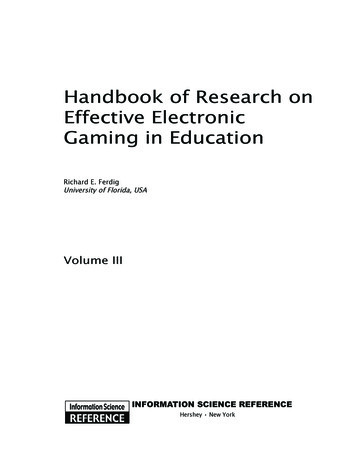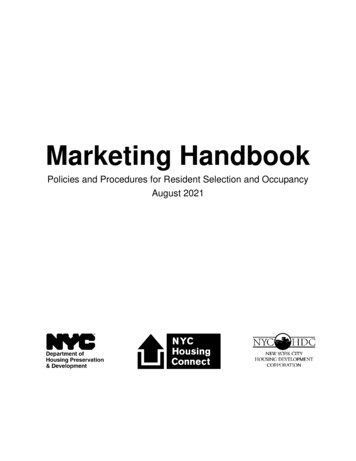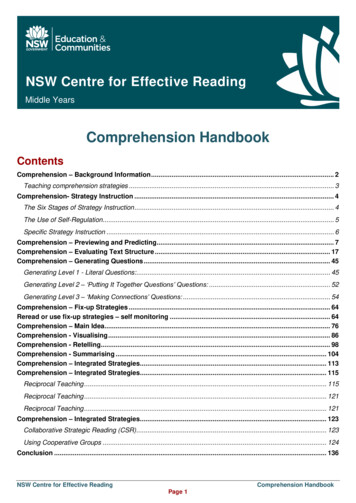
Transcription
Handbook of Research onEffective ElectronicGaming in EducationRichard E. FerdigUniversity of Florida, USAVolume IIIInformatIon scIence referenceHershey New York
Director of Editorial Content:Managing Development Editor:Senior Managing Editor:Managing Editor:Assistant Managing Editor:Copy Editor:Typesetter:Cover Design:Printed at:Kristin KlingerKristin M. RothJennifer NeidigJamie SnavelyCarole CoulsonMaria Boyer, Amanda AppicelloCarole CoulsonLisa TosheffYurchak Printing Inc.Published in the United States of America byInformation Science Reference (an imprint of IGI Global)701 E. Chocolate Avenue, Suite 200Hershey PA 17033Tel: 717-533-8845Fax: 717-533-8661E-mail: cust@igi-global.comWeb site: http://www.igi-global.comand in the United Kingdom byInformation Science Reference (an imprint of IGI Global)3 Henrietta StreetCovent GardenLondon WC2E 8LUTel: 44 20 7240 0856Fax: 44 20 7379 0609Web site: http://www.eurospanbookstore.comCopyright 2009 by IGI Global. All rights reserved. No part of this publication may be reproduced, stored or distributed in any form or byany means, electronic or mechanical, including photocopying, without written permission from the publisher.Product or company names used in this set are for identification purposes only. Inclusion of the names of the products or companies doesnot indicate a claim of ownership by IGI Global of the trademark or registered trademark.Handbook of research on effective electronic gaming in education / RichardE. Ferdig, editor.p. cm.Summary: "This book presents a framework for understanding games foreducational purposes while providing a broader sense of current relatedresearch. This creative and advanced title is a must-have for thoseinterested in expanding their knowledge of this exciting field of electronicgaming"--Provided by publisher.Includes bibliographical references.ISBN 978-1-59904-808-6 (hardcover) -- ISBN 978-1-59904-811-6 (e-book)1. Simulation games in education--Handbooks, manuals, etc. 2. Electronicgames--Handbooks, manuals, etc. I. Ferdig, Richard E. (Richard Eugene)LB1029.S53H36 2008371.39'7--dc222007052787British Cataloguing in Publication DataA Cataloguing in Publication record for this book is available from the British Library.All work contributed to this book set is original material. The views expressed in this book are those of the authors, but not necessarily ofthe publisher.If a library purchased a print copy of this publication, please go to http://www.igi-global.com/agreement for information on activatingthe library's complimentary electronic access to this publication.
1010Chapter LVIIIThe Design, Play, andExperience FrameworkBrian M. WinnMichigan State University, USAAbstrActThis chapter introduces a framework for the design of serious games for learning, called the design,play, and experience framework. The author argues that the great potential of serious games will not berealized without a formal design approach. To that end, the author presents and thoroughly explains thedesign, play, and experience framework which provides a formal approach to designing the learning,storytelling, game play, user experience, and technology components of a serious game. The authorconcludes by detailing how the framework provides a common language to discuss serious game design,a methodology to analyze a design, and a process to design a serious game for learning.introductionThe serious games movement asserts that thegame medium can serve many functions, and asole focus on entertainment significantly undersells its potential (Jenkins, 2006). Serious gameshave a purpose beyond entertainment, including(but not limited to) learning, health, advertising,and social change (Prensky, 2001; Sawyer, 2002).Some serious games are thought to provide stealthlearning as players are focused not on learningbut on playing (Shreve, 2005).Serious game design is a relatively new discipline. As such, there is a lack of a commonlanguage and a lack of standard practices fordesigning serious games. To date, serious gamedevelopment teams have utilized a diverse mix ofgame design and instructional design methodologies to help realize their designs, but often without a unifying framework to bring these diverseperspectives together. This chapter describes aunifying framework to help serious game development teams achieve their full potential.Copyright 2009, IGI Global, distributing in print or electronic forms without written permission of IGI Global is prohibited.
The Design, Play, and Experience FrameworkbAcKgroundWhile learning through play is not a new concept(Dewey, 1916; Malone, 1981; Papert, 1998; Piaget,1951), increasing technical and aesthetic sophistication, and growing popularity of commercialdigital games across diverse demographics (ESA,2006), have attracted a rebirth of interest on thepart of scholars and teachers to create new andimproved games for learning (Van Eck, 2006).Evidence of perceptual, cognitive, and socialbenefits of playing games is growing (e.g., Gee,2003, 2005; Johnson, 2005; Kierrimuir & McFarlane, 2004; Lieberman, 2006; Ritterfeld, Weber,Fernandes, & Vorderer, 2004; Shaffer, 2006).Linguist and learning scholar James Gee (2003,2005) believes that games are enjoyable becauseof learning—they present just the right amount ofchallenge, support, and feedback, progressivelyrewarding mastery with new challenges. Thisexperience parallels other known optimal statesof happiness, or flow (Csikszentmihalyi, 1990).The structure of games mirrors good pedagogy, offering progressive problem solving andscaffolded learning. Van Eck (2006) demonstratesthat games embody all phases of Gagne’s (1985)Nine Events of Instruction (events that activateprocesses needed for effective learning). Theseevents are: gain attention, inform learner of objectives, stimulate recall of prior learning, presentstimulus material, provide learner guidance, elicitperformance, provide feedback, assess performance, and enhance retention and transfer.Games excel where traditional in-personclassroom training and online Web-based training fall short. Most notably, games are effectiveat engaging students and making them an activeparticipant in their education process. Amongeducation scholars, this is referred to as activelearning. Active learning is a form of constructivism, based on a student-center model of instruction (Svinicki, 1999). Active learning assumesthe student must be active in the construction ofhis or her own knowledge, what Dewey (1916)referred to as learning by doing, rather than apassive recipient of information. Active learning has been shown to promote better recall,enjoyment, and understanding than traditionalinstructional techniques, such as lecturing (Gibbs,1992; Mujis & Reynolds, 2001; Petty, 2004) andis the cornerstone of other progressive pedagogy,including problem-based learning and collaborative learning.Communication and education scholar Deborah Lieberman (2006) lists eight learning benefitsof games: Games provide the player with an activeexperience.Games encourage the player to learn bydoing.Games are a social medium providing theplayer with human-to-human like interactions and emotional responses.Games are participatory by providing theplayer with customized, rapid feedback.Games are engaging. Participation makesthe player pay close attention. It demandsthoughtful planning and decision making.It demands learning in order to succeed (ifyou don’t learn, then you can’t succeed).Games promote behavioral learning. Thegame gives the player rewards for behavior(points, power, rank, and so forth). Thispositive feedback in the game can encouragedesired behaviors in real life.Games offer consequences. These are notabstract or hypothetical; they are representedin the game directly. The player plays acharacter and identifies with him or her.Success and failure map directly to theplayer’s actions; one’s ego and self-imageare invested in the experience.Games provide role models for the player.The player can learn from the game characters and understand their behavioralexperiences.1011
The Design, Play, and Experience FrameworkSerious games offer serious opportunities forlearning, but only if the game is designed effectively. The design process is a creative, sometimeschaotic process. Making a good game is hard.Making a good serious game is even harder. Thereason it is so difficult is that rather than simplytrying to optimize the entertainment aspect ofthe game, or the so-called fun factor, one mustalso optimize to achieve a specific set of seriousoutcomes. For example, the NSF-funded LifePreservers game was designed to be an appealing,entertaining game for middle school students ofboth genders while teaching the national sciencestandards on evolution and adaptation, as well asserve as the stimulus for research on gender andplay-testing in learning games. This was not aneasy task (Heeter, Winn, & Greene, 2005).In designing Life Preservers, it was realizedthat there are three perspectives on designingserious games: that of the academic, interested invarious academic theories, be they from educational pedagogy, communication theory, and soforth; that of the content expert, interested in thegiven subject matter; and that of the game designer,focused on creating engaging and entertaininggame play (Winn & Heeter, 2006/2007). On atypical development team, a different individualor group of individuals usually represents eachFigure 1. Heart of serious game design1012of these perspectives. In order to have a seriousgame that met its goals, the Life Preservers’ teamquickly discovered that they needed to convergeon game design features so that the theory,content, and game design were compatible andcomplementary.The overlap between theory, content, and gamedesign form, what we have dubbed, the heart ofserious game design (see Figure 1). The conceptof the heart of serious game design parallels thetechnological pedagogical content knowledge(TPCK) model proposed by Mishra and Koehler (2006). This model defines the overlap inknowledge about technology, pedagogy, andcontent as TPCK. TPCK is an emergent form ofknowledge that goes beyond the three individualcomponents to yield a result that is more thanthe sum of its parts. The same sort of emergentknowledge between theory, content, and gamedesign is particularly relevant for realizing effective serious game designs. One of the greatestchallenges that collaborative teams face in thedesign of serious games is working through theirdisciplinary tensions and converging on the heartof serious game design.To be sure, such tensions will vary dependingon the nature of the serious game in question. Inthe case of exogenous educational games, con-
The Design, Play, and Experience Frameworkflicts between theory, content, and game designrarely arise since the game mechanics and pedagogical theory are already defined at the outset.Such games separate learning content and gamemechanics (Halverson, 2005; Malone & Lepper,1987). Designers of exogenous educational gamestypically reuse successful game mechanics, suchas hangman, a Jeopardy-style game show, or aSpace Invaders-style shooter, inserting the contentto be learned into the pre-existing game structureand rules. Content is often the only new input,and the learning tends to be limited to reinforcing knowledge recall. This can be seen in earlyedutainment titles, such as Math Blaster1 or morerecent Web-based titles such as Trivia Archer2.In contrast, endogenous educational gamestarget more complex learning goals beyond memorization and do so in part by integrating learningcontent into the structure of the game (Halverson,2005). Like exogenous games, endogenous gamesfrequently adopt familiar game genres such as roleplay or adventure games, board or card games,or puzzles. The defining characteristic of endogenous games, however, is that the game play itselfinforms the pedagogical theory and embodies thelearning content. By requiring players to explorethe game space and use their knowledge to meetgame challenges, designers of endogenous gamespromote active problem solving and reinforcecontext-specific learning goals. Consequently,endogenous educational game designers beginwith a more or less blank slate. They seek an idealized convergence of content, theory, and gamedesign that achieves the hypothetical potentialof games to promote advanced forms of learning(aka, the heart of serious game design). The vastchallenge being, of course, is that this ill-specifieddesign problem has infinite possible solutions.Oregon Trail (MECC, 1985) is an example of anearly endogenous learning game. More recentexamples include Life Preservers (2006), HotShot Business3, and Times Attacks4.the mdA FrAmeWorKThe mechanics, dynamics, and aesthetics (MDA)framework was designed and taught by MarcLeBlanc (2005a) to “ clarify and strengthen theiterative processes of developers, scholars andresearchers alike, making it easier for all partiesto decompose, study and design a broad classof game designs and game artifacts” (Hunicke,LeBlanc, & Zubek, 2004, p. 1).The MDA framework depicts the relationshipof the designer and the player (see Figure 2). Thedesigner designs the mechanics or formal rules ofthe game. These rules are instantiated at play timeand influenced by the player’s inputs, forming thedynamics, or run-time behavior of the game. Theaesthetics of the game are the resulting emotionalresponses in the player when playing.In this framework, the designer only has directcontrol over the mechanics of the game. Therefore,the designer must determine the desired aesthetiche or she hopes to create for the player and thendesign the mechanics to achieve these desiredaesthetic. The designer utilizes play-testing andgame balancing to modify the mechanics overtime to achieve the desired aesthetic through aniterative process.While the MDA framework has proven to be auseful approach to designing and analyzing gameplay (LeBlanc, 2005b), it does not specificallyFigure 2. The MDA framework MechanicsDesignerDynamicsAesthetics Player1013
The Design, Play, and Experience Frameworkaddress aspects of game design beyond the gameplay, including the storytelling, user experience,and influence of technology on the design. Thisis partially due to the game play-centric languageused in the framework. For example, we can attempt to decompose the mechanics, dynamics, andaesthetics of the storytelling and user experience,but the semantics of the terminology often get inthe way of doing so. This approach also jettisonsthe discipline-specific language used in storytelling and user experience design.Further, the MDA framework focuses on thedesign of games for entertainment. Designingserious games offers a unique set of design challenges (Winn & Heeter, 2006/2007) that are notencompassed in the MDA framework.Similar to the MDA framework, the DPEframework depicts the relationship betweenthe designer and the player (see Figure 3). Thedesigner designs the game, the player plays thegame, which results in the player’s experience.The designer only has direct control over thedesign itself. To design a game effectively, thedesigner should first come up with goals for theresulting experience. These goals can be used bothto guide the design and to gauge the effectivenessof the design once implemented. The arrow fromexperience back to design represents both theinfluence of the goals on the original design andthe iteration on the design once a prototype of thegame is tested against the experience goals. Thisreflects the inherently iterative process of gamedesign (Salen & Zimmerman, 2004), includingdesigning, prototyping, play-testing, and iteratingback to the design based on the experience of theplay-testing (see Figure 4).However, play is a mediated experience. Playis greatly influenced by not only the design, butalso the player, including his or her cognitive,social, cultural, and experiential background thathe or she brings to the given play experience.Therefore, the experience of one player maybe profoundly different than the experience ofanother player. The target audience for the gamemust be strongly taken into account throughoutthe design process.the dPe FrAmeWorKThe design, play, and experience (DPE) framework was created as an expansion of the MDAframework to address the needs of serious gamedesign for learning, while also attempting toaddress some of the semantic barriers describedearlier. The DPE framework presents a languageto discuss design, a methodology to analyze adesign, and a process to design a serious gamefor learning.Figure 3. The DPE framework DesignerDesignPlayExperienceFigure 4. Iterative design processP ro to typeD esig n1014P la ytest Player
The Design, Play, and Experience FrameworkFigure 5. Expanded DPE framework DesignPlayExperienceL ea rningContent andPedagogyT eachingL earningS to rytellin gCharacter, Setting,and NarrativeStorytellingStoryG a m e p la yMechanicsDynamicsU se rE xp e rienceUser InterfaceInteractivityDesignerPlayerE ngagementT echnologyThe expanded DPE framework (see Figure5) depicts the sub-components of serious gamedesign, including the learning, storytelling, gameplay, and user experience layers. Each layer hasa design, play, and experience aspect (describedin the figure). Technology is represented in thebottom layer. While the designer does not necessarily design the technology, the design itself isrealized (or not) on the technology.While the serious game design process isoften led by a team of individuals with diverseexpertise (as described earlier), to simplify theconversation, the design team will simply bereferred to as the designer in the discussion thatfollows. To that end, the potential players of theserious game will be discussed as a figurativeindividual player.learning layerIn the learning layer, the designer designs thecontent and pedagogy, which results (hopefully)in teaching when the player plays the game. Thisleads to a set of learning outcomes (either realizedor not) derived from the overall experience.As described previously, the designer shouldfirst come up with goals, or in this case, learningoutcomes for the resulting experience and thendesign the content and pedagogy to meet thesegoals. Just as an instructor might do in their curriculum development, the designer can define theirlearning outcomes using proven instructionaldesign techniques.Bloom’s Taxonomy on Teaching and Learning(1956) is useful in thinking about and generatingthe student learning outcomes in serious game design. This taxonomy defines three types of learning, including cognitive, psychomotor, and affective learning, commonly simplified as knowledge,skills, and attitude (KSA). The taxonomy alsofurther sub-categorizes cognitive and affectivelearning into a range of behaviors, from simplestto advance. For example, cognitive learning issub-categorized into knowledge, comprehension,application, analysis, synthesis, and evaluation.While Bloom’s taxonomy did not sub-categorizepsychomotor learning, others since have (Dave,1975; Harrow, 1972; Simpson, 1972).There are many resources available to helpserious game designers generate student-learningoutcomes using Bloom’s taxonomy (e.g., Clark,1999) or using any number of other learningtaxonomies. The main point is to take the timeearly in the design process to think about and rigorously define your learning goals. The goals notonly form the basis for the design of the contentand pedagogy but also can form the basis for theassessment of the game’s learning effectivenesson the player. With an increase in focus on testingand monitoring student performance, generatingeffective forms of assessment is rapidly becominga must for any serious game.1015
The Design, Play, and Experience Frameworkstorytelling layerThere are two perspectives on storytelling ingames: the designer’s story and the player’sstory (Rouse, 2001, p. 216-218). The designer’sstory is the storytelling that is designed into thegame. The designer’s story can be used to setthe stage, provide purpose and engagement, andconvey content, among other things. The setting,character design, and narrative are the designersprimary design tools.The storytelling that occurs during play combines the designer’s story with the interactions andchoices the player makes. The resulting experience crafts the player’s story. Some games havestronger designer stories, such as adventure androle-playing games, while others have little to nodesigner story, such as classic arcade games likePacman and puzzle games like Tetris. However,all games have a player’s story, which at the veryleast reflects the story of the game play challengesencountered by the player and how the player addressed them. When approaching a design, thedesigner must first decide on what type of storieshe or she wants the player to be able to experience and design the setting, character design, andnarrative to achieve this.The learning outcomes often complicate thestorytelling in serious game design. For example, ifyou are developing a serious game to teach history,how much can the games storytelling deviate fromthe actual events of history and still accomplish itsobjectives? If you are developing a serious game toteach science, can your storytelling integrate elements of science fiction? Each of these importantstorytelling design decisions must be temperedwith the desired learning outcomes.game Play layerThe game play layer defines what the player doesin the game. That is, what choices the player canmake in the game world and what ramificationsthose choices will have on the rest of the game1016(Adams & Rollings, 2007, p. 277). The game playlayer is broken down into mechanics, dynamics,and affects. The mechanics are the rules that definethe operation of the game world, what the playercan do, the challenges the player will face, andthe player’s goals. The dynamics are the resultingbehavior when the rules are instantiated over timewith the influence of the player’s interactions. Theresulting experiences, or emotions derived in theplayer, are the affects.The game play layer most closely resembles theoriginal MDA framework that was the inspirationof the DPE framework. The notable exception isthe change of terminology from aesthetics, whichfor many represents a visual arts term representingthe beauty of something, to affect, a psychologicalterm meaning emotion or desire.As in the MDA framework, the designer musttake a formal approach in defining what emotionshe or she wants to raise in the player. From aplayer’s perspective, the game may be describedas fun or not fun. However, as a designer, it isimportant to move beyond simply describing thedesired emotion as fun. The designer must decompose fun and understand the particular aspectsthat derive a fun experience in the player.Marc LeBlanc lists eight kinds of fun as aesthetic goals (Hunicke, LeBlanc, & Zubek, 2004),which I will refer to here as affective goals. PierreAlexandre Garneau (2001) wrote an article thatproposed 14 forms of fun. Heeter, Chu, Maniar,Mishra, Egidio, and Winn (2003) expanded thisto 16 forms of fun, including beauty, immersion,intellectual problem solving, competition, socialinteraction, comedy, thrill of danger, physicalactivity, love, creation, power, discovery, advancement and completion, application of an ability,altruism, and learning.LeBlanc further formalizes the process ofdefining the affective goals by creating a rigorousdefinition of each goal, which includes criteria forsuccess and failure. For example, LeBlanc (2005a)defines competition as a game where the playersare emotionally invested in defeating each other.
The Design, Play, and Experience FrameworkFigure 6. Balancing the level of difficultyToo DifficultChallenge(Frustration)elannhwCFloLow SkillHigh SkillToo Easy(Boring)SkillThe players are adversaries and want to win arethe criteria for success while the players feel thatthey cannot win or players feel they are unableto gauge their progress are criteria for failure ofthe model.Once the affective goals are defined, the designer must then devise the mechanics to realizethese goals through the dynamics of the playexperience.The only way to determine if the mechanicsactually do realize the affective goals is throughplay-testing. With appropriate formal modelsfor success in hand, it becomes quickly apparentto what degree the goals are being reached. Thedesigner can then use this information to modifythe mechanics to better achieve the goals. Thisprocess is known as balancing the game. Severaliterations of designing, prototyping, play-testing, and revising are often required to balancea game.One common form of game play balancing isthe balancing of the level of difficulty. Figure 6contains psychologist Mihaly Csikszentmihalyi(1990) theory of flow, which demonstrates that inorder for the flow state to be achieved, the level ofchallenge must match the player’s abilities as hisor her skills increase. If the challenge is too great,the player will become frustrated and may giveup. If the challenge is too little, the player willquickly become bored and may quite playing.Another form of game play balancing relatesto the frequency of rewards given to the player.Figure 7 represents a common learning curve inthe game. A designer usually wants to balancethe game so that the player is rewarded moreoften (represented as stars) during the steepestpart of the game’s learning curve, or during themost challenging parts of the game, in order tokeep the player playing. This can be thought asa form of operant conditioning with the rewardsrepresenting reinforcements at key points asthe player learns how to play and overcome thegame’s challenges.The designer often also needs to balance theprogression of play. Early in the game the playermay be overwhelmed with a great deal of choicesas they learn how to play. Therefore, the designeroften wants to limit the choices early in the gameand then ramp the number of choices up as thegame progresses as shown in Figure 8. The typical pattern for introducing new choices is that thedesigner will present the player with a new goalin the game. The player will need to gain somenew skill in order to achieve the goal. The playerwill learn and practice this new skill until theymaster the skill and finally achieve the goal. The1017
The Design, Play, and Experience FrameworkChallengesFigure 7. Balancing the frequency of rewardsLinrnaerveugC rew ardTimeChoicesFigure 8. Balancing the progression of playTimeprocess then repeats, building on the previouslyintroduced skills.Rollings and Adams (2003, p. 240) state, “abalanced (entertainment) game is one where themain determining factor for success of the playeris the skill level of that player.” While this isoften true as well in a serious game, the goals inbalancing a serious game often are influence byadditional factors, most notably factors relatedto the desired learning outcomes (see section on“Influence Between Layers”).user experience layerWhile the user experience layer is represented asthe deepest layer in the framework, it is actually themost visible (or surface) layer from the perspectiveof the player. Bruce Shelly with Ensemble Studios,a well-known designer of entertainment games,1018once said, “the game designer’s principal goal isto create entertaining game play. The purpose ofthe interface is to make that entertainment accessible” (Saltzman, 2000, p. 256). While this is trueas well for serious games, the purpose of the userinterface is also to create a vehicle to realize thedesired serious outcomes.The game design manifests itself throughthe user interface. The interface encompasseseverything the user sees, hears, and interacts withand how that interaction happens (i.e., the controlsystem). Ultimately the goal of the designer is(usually) to develop a game that immerses theplayer in the game world and engages them in theplay experience. Good user interfaces are said tobe transparent, that is, the player does not haveto focus their attention on how to play the game(i.e., what button to press) but rather on the gameplay, storytelling, and learning experience.
The Design, Play, and Experience FrameworkInfluence Between Layerstechnology layerThe vertical arrows shown in Figure 5 reflect thefact that each layer has influence over the otherlayers. For example, the learning will influenceand be influenced by the storytelling, game play,and user experience. Certain design decisions arecomplementary or conflicting across the layers.Sherry and Pacheco (2004) argue that seriousgames for learning are most effective when agame’s game play matches the desired learningoutcome. They developed a heuristic for mappingdifferent types of learning, based on Bloom’s taxomony, to game genres. Marc Prensky (2001, p.156) developed a similar table that maps differenttypes of learning to potential activities and gamestyles. For example, for the learning of skills,Prensky proposes the use of “imitation, feedbackcoaching, continuous practice, and increasingchallenge” for learning activities, and “role-playgames, adventure games, and detective games”as potential game styles.When making design decisions, you mustalways consider the impact of those decisionson the other aspects of the game. In working outdesign conflicts, I suggest starting with the topmost layer and working you way down. For mostserious games for learning, the learning is the mostimportant aspect and usually the least malleable.Storytelling is often tied closely to the learningcontent and therefore should be addressed next,but is usually much more malleable. The gameplay and user experience layers are the mostmalleable and often must adapt to the learningand storytelling. However, as discussed, designis an iterative and creative process. Decisions inlower levels and discovers in play-testing willinfluence you design across all layers and shouldbe addressed. For example, ce
storytelling, game play, user experience, and technology components of a serious game. The author concludes by detailing how the framework provides a common language to discuss serious game design, a methodology to analyze a design, and a process to design a serious game for learning.











